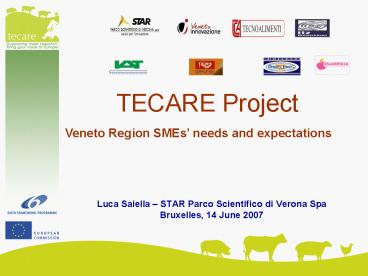TECARE Project - PowerPoint PPT Presentation
1 / 11
Title:
TECARE Project
Description:
Veneto is the second largest meat producer among italian regions, with a ... levels of surplus can be found in Brittany (France) and in Lower Saxony, Germany. ... – PowerPoint PPT presentation
Number of Views:63
Avg rating:3.0/5.0
Title: TECARE Project
1
TECARE Project
Veneto Region SMEs needs and expectations
- Luca Saiella STAR Parco Scientifico di Verona
SpaBruxelles, 14 June 2007
2
General overview
- Veneto is the second largest meat producer among
italian regions, with a 14 share - 82 of the total value of production is made up
by poultry (42) and cattle (40) - A concentration process is going on, with a few
big players and many small enterprises
3
SMEs involvement
- STAR involved a large number or local SMEs,
associations and technical experts, in order to
identify the most popular industrys needs - A database of 500 target companies was created
they were invited to the kick-off meeting and to
the following geographical working group - 40 actors participated in the launch meeting (23
of them were SMEs) - 16 actors participated in the GWG (5 of them were
SMEs)
launch meeting invitation
4
Needs emerged
- Topics emerged sanitary controls during
production, animal farming dejections management,
traceability along the supply chain, shelf-life
improvement and consumers information - A specific need was identified as the most urgent
issue for SMEs (and for big companies too)
elimination of excess nitrogen produced with the
dejections of animals, because (used as
fertilizers) they are polluting surface and
underground waters, bringing to a EU Commision
Directive.
traceability
controls
dejections
shelf-life
consumer
dejections management for nitrogen eleimination
5
Nitrogen issue
- The EU Commission Directive on nitrogen pollution
in waters focuses on the environmental effects of
excess nitrogen, in particular eutrophication
(i.e. excessive nutrients in a body of water,
usually caused by runoff of nutrients like animal
waste or fertilizers from the land, which causes
a proliferation of plant life, especially algae,
which reduces the dissolved oxygen content and
often causes the extinction of other organisms.)
6
Involved EU regions
- The highest national nitrogen surpluses are found
in regions of the Netherlands and Belgium (gt 150
or 200 kg N/ha year). The same levels of surplus
can be found in Brittany (France) and in Lower
Saxony, Germany. Surplus of the order of 100-150
kg N/ha year are also found in Member States with
relatively low national surplus such as Spain
(Catalonia), Italy (Lombardia, Veneto), the
United Kingdom (Northern Ireland, Wales and West
England).
REPORT FROM THE COMMISSION TO THE COUNCIL AND
THE EUROPEAN PARLIAMENT on implementation of
Nitrates Directive (2007)
7
Directive implementation
- The implementation of the Directive includes
detection of polluted waters, designation of
"vulnerable zones" (NVZs), code of good
agricultural practice, Action Programs within
NVZs (Code of good agricultural practice becomes
mandatory other measures like spreading lt170 kg
N organic/hectare/year), national monitoring - In 2007 the Directive implementation is still
incomplete, as confirmed by infringement
procedures for 7 old Member States, mainly for
insufficient designation of nitrate vulnerable
zones (BE, ES, IE, IT, PT, UK) and non conformity
of action programmes (BE, DE, ES, IE, IT, UK) - New Member States fulfilled their obligation by
ensuring transposition, having a water monitoring
network in place and designation of nitrate
vulnerable zones. Action programmes are now
established in all new Member States. The
Commission is analysing the designation and the
action programmes to assess their compliance with
the Nitrates Directive.
REPORT FROM THE COMMISSION TO THE COUNCIL AND
THE EUROPEAN PARLIAMENT on implementation of
Nitrates Directive (2007)
8
Research interests
- SMEs are interested in
- Using animal dejections to produce biogas
- Research of new and efficient ways to lower the
nitrates level inside the liquid outputs of the
biogas production process - Understanding which is the optimal scale of a
biogas plant - Being informed about different solutions
available, to chose the one that best fits their
kind of business, animals, farmland, country
regulations, etc (they are confused)
REPORT FROM THE COMMISSION TO THE COUNCIL AND
THE EUROPEAN PARLIAMENT on implementation of
Nitrates Directive (2007)
9
Pilot plant research strategy
Studying the optimal plant size, quantity and
quality of dejections, measuring the nitrates
levels of inbound and outbound wastes,
experimenting ways to reduce nitrates in liquids,
measuring the economic return of the plant
energetic production and the environmental
benefits.
REPORT FROM THE COMMISSION TO THE COUNCIL AND
THE EUROPEAN PARLIAMENT on implementation of
Nitrates Directive (2007)
10
Survey research strategy
Producing a study on the different solutions
available worldwide to solve the nitrates
problem. The output would be a technical user
guide with a software application for SMEs,
aimed at helping them in orientating among
different technologies and choosing the solution
that best fits their kind of business, land,
climate, animals, nutrients, etc.
REPORT FROM THE COMMISSION TO THE COUNCIL AND
THE EUROPEAN PARLIAMENT on implementation of
Nitrates Directive (2007)
11
Research consortium
- Enterprises, research institutes and associations
from 4 different EU Member States expressed their
interest in participating to a research on the
nitrates topic - Acronym for a research project NITRATE-CARE,
giving a sense of continuity with the Tecare
Project - Thank you for your attention!
REPORT FROM THE COMMISSION TO THE COUNCIL AND
THE EUROPEAN PARLIAMENT on implementation of
Nitrates Directive (2007)































